Mining for water on MARS! Could it sustain our future colony?
I am going to use my knowledge and drill through all the current scientific studies in order to bring you a Mars Colonization Handbook, which will highlight the most successful methods of dealing with each of the colonization challenges. Last time we talked about generating oxygen on Mars and the challenges of doing it.
This week I already did some new fact checking in this field, I am also an avid Quora reader. Science doesn't have to be boring and it might even help you in case of a zombie attack :).
This being said I will try to present the science in an easy to read way, today's article will be even easier. How hard can it be to find and process water on a far away frozen and dried out atmosphere-losing planet?
First reports of water on Mars
Mariner 9 was launched in 1971 and was the first Mars orbiter that contributed a lot to the exploration of Mars. The previous Mariners focused on Venus, were lost at launch, or simply sent too little back in terms of research. Mariner 9 sent back to the researchers photos of the surface, intriguing them.
The images received weren't too detailed and couldn't spot actual water but were enough to spot geological features that could only be explained by water erosion.
In the right you can see one of the actual pictures took by Mariner 9 of the Warrego Valles. You can barely see some channels running across the image in a vertical pattern, gaining depth as they pass through different geological surface features. There is no other physical process that would carve the landscape like this. This method has since become one of the main factors in identifying historical water deposits on other planets,at least before sampling and analyzing the soil with specialized tools . To celebrate the discovery of Mariner 9, the biggest canyon system on Mars was named in its honor: Valles Marineris, latin for Mariner's Valley. Mariner 9 is still in Low Mars Orbit, which will decay in the following years ( 2021-2022), further slowing it down until it will burn in its atmosphere, being scattered in the planetary body which it researched for so long.
The Viking Orbiter missions that ensued after were an even greater success. Massive river valleys were discovered all over the planet, clearly showing erosion during long periods of time, valley networks that could only be carved by rain water and craters with smooth edges which could only be explained by water flowing back inside after an impactor hit. An impactor is the scientific name of a meteor that doesn't burn up completely in the atmosphere. But the Viking Program also had a lander component which took samples and analyzed them using a spectrometer. A spectrometer is a scientific device to analyze the chemical composition of a sample and can identify different materials. After studying all the samples from Mars it found that water was being 1% of the mass sampled. Sulfur and Chlorine was also found, evidence that water evaporated at some point.
Usual minerals found with the use of spectrography and mineral measurement:
- Sodium Sulfate
- Magnesium
- Calcium
- Iron
- Hematite
- Magnetite
- Goethite
Thus, irrefutable evidence of previous water was identified and the subsequent missions found more evidence using more and more sophisticated measurement tools. Mars Global Surveyor found olivines that could explain the formation of the above listed minerals and even open the possibility of much more recent liquid water sightings.
Mars Pathfinder opened up the possibility of finding liquid water in the present by analyzing the temperature fluctuations during a Martian day and night in the form of salts keeping it from freezing or evaporating. Even the presence of clouds and fog was sighted.
The Mars Odyssey confirmed the presence of water :
Using instruments on NASA's 2001 Mars Odyssey spacecraft, surprised scientists have found enormous quantities of buried treasure lying just under the surface of Mars-enough water ice to fill Lake Michigan twice over. And that may just be the tip of the iceberg.
The Phoenix lander stirred a lot of debate when it photographed ice sublimation during its stay there and even measured the existence of Perchlorates, used by some bacteria on Earth for metabolic function.
Facts about water on MARS
So now we know for sure that water exists on the surface of Mars. It cannot exist in a liquid form because of the very reduced atmospheric pressure ( 0.6% of Earth's pressure ) but there are huge amounts of water at the poles manifested as ice caps and under the surface across the planet. Vapors are also present and further information shown by the above discussed missions highlight a very different Mars in the past
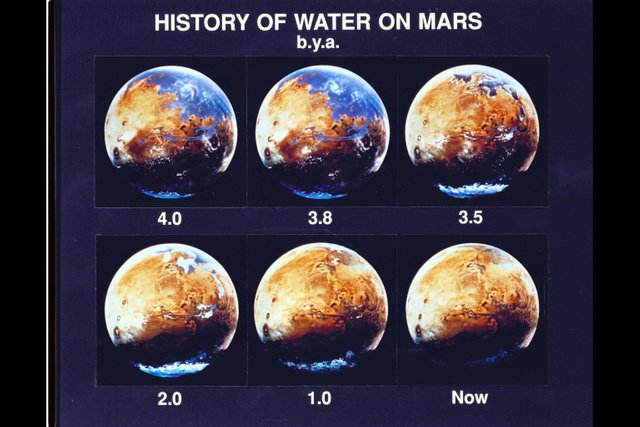
NASA composite depicting the evolution of liquid water across Mars.
How can we start producing the water?
According to a study made by California Institute of Technology in 2016 about water ISRU ( In-Situ Resource Utilization -locally producing resources ) on Mars, the necessary water could be processed according to our quantitative needs but additional research needs to be done in order to find the perfect location in terms of yield versus energy used.
There are a lot of key factors to be taken into account, and further probing is needed, perhaps the best locations will be discovered once the humans will already get there as they can travel much farther and get samples faster than the robots.
The water produced and the system used to refine it depends also on the use of glacial ice, of poly-hydrated sulfate minerals, phyllosilicate minerals or just surface regolith with the pre-scouted characteristics.
Definition of terms:
- Glacial ice - ice that is deposited on the polar ice caps
- Poly-hydrated sulfate minerals - minerals that resulted after water evaporation and contain the most water locked inside their structure.
- Phyllosilicate minerals - minerals that also contain water within their parallel sheeting of silicates. Clay the most known example. -
- Regolith - surface minerals exposed to the atmosphere or just under the surface.
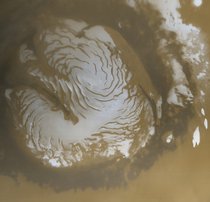
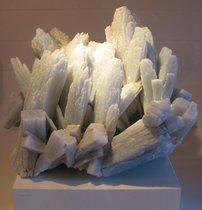
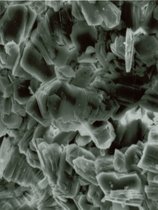
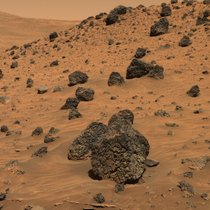 All images are WC/NASA, CC0 or in the public domain.
All images are WC/NASA, CC0 or in the public domain.
From left to right an exemplification of glacial ice, sulfate minerals, phyllosilicate minerals and surface regolith.
The use of glacial ice would fare better in the aspect of transport time but would fare poorly as impurities and dust could increase sterile yield ( soil that would be uselessly carried and then deposited in huge mounds which could be taken by wind due to their very fine granulation as a result of processing and deposited on the solar panels causing extensive damage and reduction in solar energy yield)
The use of minerals would fare better regarding the actual mass of raw material and the power required to process, with the best being the poly-hydrated sulfate minerals ( holding the most water) and the least promising being the surface regolith because of lower concentration levels.
In the adjacent comparison you can see the reduction in mass provided by the use of ISRU ( in metric tons) They only compare the mass of the propellant needed to bring back the spacecraft to Low Earth Orbit, not taking into account the mass of the propellant needed to deliver the rocket there in the first place. So the resulting efficiency is potentially even greater by using ISRU. The study found mass reduction by a factor of 6. This means that for every kg of the system delivered there we could expect an return ratio of 22:1 for a mixed Liquid Oxygen -Liquid Methane ( Lox/LCH4)

Source: Beaty et al.(2016) study.
Bored yet? Let's spice it up a little by putting an face to this ISRU we keep talking about!
Source: NASA presentation.
So basically a rover that would find and eat minerals, up to 40 pounds a day, working most of the day and spewing the contents in a bin that gets carried via a conveyor belt to the refinery. Pretty simple right? And having a fleet of 3-4 of these rovers could speed up the process.

This is an example of a standalone ISRU, probably sent over multiple deployments, also including the power source. Source: Water ISRU planning study, NASA.
By sending the power sources and the ISRU before of the actual mission, by 2 years, it can use the time to prepare and start mining and processing. The materials can be deposited without the fear of affecting solar panels or contaminate other experiments that the human missions will bring or deploy. By the time the manned mission arrives the resources would be ready for transfer and use. Using the data from the study ( which is scaleable either by size or by number of ISRU units on the surface) we can conclude that obtaining water is done at sustainable rate of 33 kg or 72 pounds per sol (Martian day which is 24 h 39 m 35 s in Earth units.). By using the time between the closest approaches of Earth and Mars we can calculate an estimate reserve of 16 metric tons of water. This is 4 226 gallons to use by our colonists and we can assume that by the time the human manned mission reaches the surface, all the capacity of the ISRU will be transferred to the new craft, so the ISRU can resume its work.
Another thing that is worth mentioning is that the ISRU producing water is also producing Oxygen, thus fuel needed to send both the units onto the ground is also saved. Furthermore, both water and oxygen is paramount for fuel ISRU that we will talk in one of the next articles on the matter, already having set the basics.
Conclusion: We have the main research!
We just need to figure the small details, reliability, maintenance - manned or unmanned and actually send the ISRU there. Also, relying on the private sector would help as this would count as an investment in future asteroid mining, which the private sector is really keen on exploring. Elon Musk’s SpaceX already acknowledged the importance of the ISRU and incorporated it into his own study, although with limited data. He also plans to land an ISRU by 2024, the time when the first people are planned to set foot on Mars, according to him. The size of it is not yet known or its capabilities but he said that more will be made public once his new Mars delivery system, the BFR, is launched.
Sources:
Presented inline, further reading or fact-check: 1,2,3,4,5,6,7,8,9.
Images are public domain or CC0 ( licences linked where possible).
Don’t forget to follow me and vote me if you find it interesting or helpful, I don’t post very often and I try instead to keep my articles of the highest quality I can. With the rewards I get, I am always curating other new authors either by promoting their works whenever I can or by following and mentoring them via comments or even one-on-one on Discord. Found great guys and girls! Thanks for funding me! It means the world to me to be able to bring science to everyone and use the voice i never thought I had.
PS: Tomorrow is the 60th day of Steemit for me! 25-50 reputation in 60 days. Thanks again!
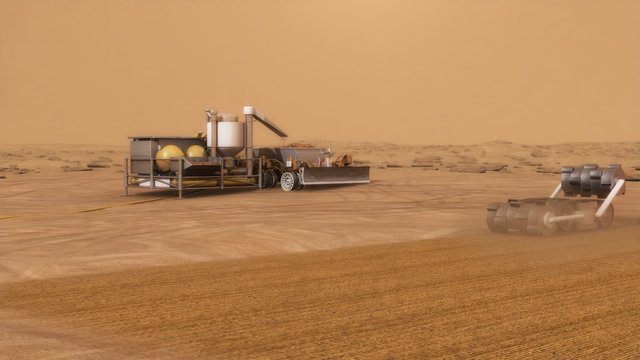

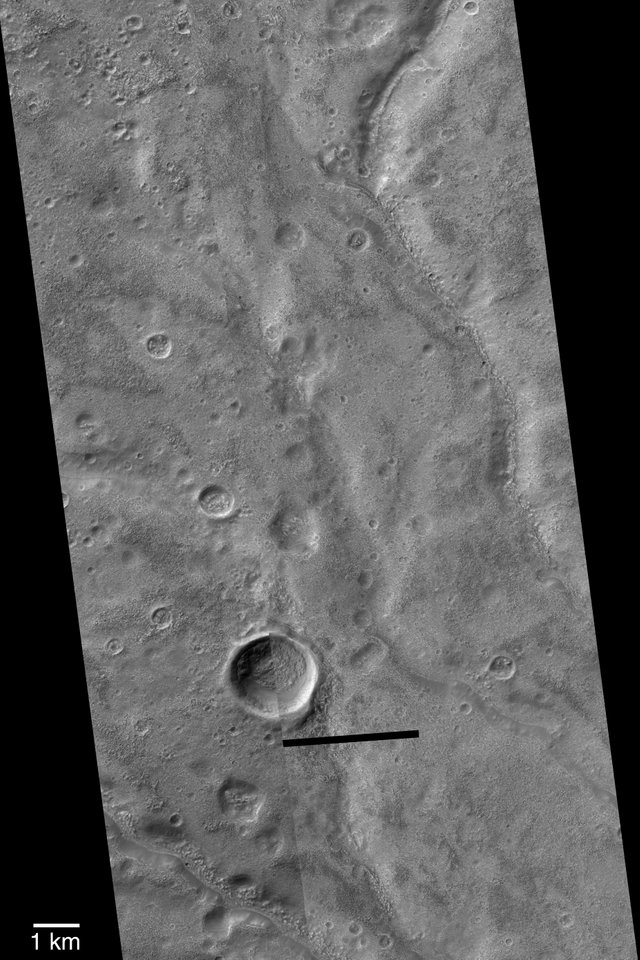
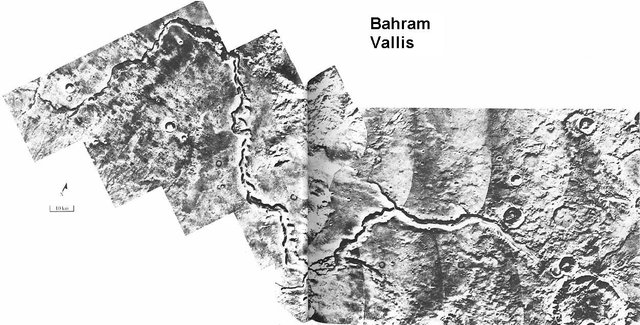
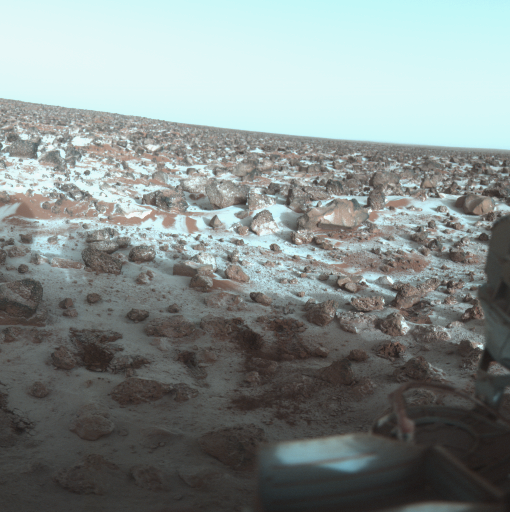




Being A SteemStem Member
I hope that first we start to appreciate the resources we have on this amazing planet!
They are not exclusive. I am also interested in ecology..
Congratulations! This post has been chosen as one of the daily Whistle Stops for The STEEM Engine!
You can see your post's place along the track here: The Daily Whistle Stops, Issue # 71 (3/12/18)
The STEEM Engine is an initiative dedicated to promoting meaningful engagement across Steemit. Find out more about us and join us today!
What about towing or slingshot ice balls from the asteroid belt (or wherever else it is found, under zero g). If the ice is controlled so that minimum damage is caused, we could mulitply the amount of water avaiilable, without having to strip the little there is.
Before we do anything, I was hoping we would first explore and study the planet. It does not look like it will happen and we will just rush in and do what we want for our own benefit, and cry later and castigate ourselves for destroying...whatever it is we destroy. It is a great system, for it means we never have to learn, we never have to "know better"
This article is focusing only on near-future resources needed for habitation. Probably just for the first 10 years of habitation. During the long run, the asteroid belt objects can come into place, and many other techniques I have read about. Stay tuned and I promise I will write about them in a later chapter.
I talked previously in my series about the Planetary Act:
"Terraforming in the long run
Some other preliminary studies cover the introduction of certain bacteria and algae, that could survive in the current Martian environment and if spread in a sufficiently big enough area could thrive and contribute to the gradual martian atmospherical composition change. However this is not allowed yet, under the Planetary Protection act. This is in place due to the fact that Mars has a high probability of hosting life which could be endangered by introducing new forms of life."
from: https://steemit.com/mars/@alexdory/can-we-make-enough-breathable-air-in-our-future-mars-colony-colonization-of-mars-series
I really appreciate your concern, it is also one of mine as I really believe that we will find some sort of evidence of life there ( at least past). It seems more unlikely not to find evidence of life as all the criteria are currently being met.
The Mars trilogy by Kim Stanley Robinson has the tension between terraformers and conservationists as a running theme. Particularly in the first two books. You may want to check it out.
Hi, I found some acronyms/abbreviations in this post. This is how they expand:
Resteemed your article. This article was resteemed because you are part of the New Steemians project. You can learn more about it here: https://steemit.com/introduceyourself/@gaman/new-steemians-project-launch . If your post has more upvotes, your post will appear in the trending page. To get more upvotes, you can bid for @steembidbot vote. please check it out here: https://steembottracker.com/
This is such a great piece of work, I can see that you really put in effort in explaining to the public. Even me with limited scientific understanding could understand it and I definitely think that it's a very interesting topic to be discussed and wondering what's going to happen in the future.
Always happy to hear that. We should have more scientists working for our greater good, and this is happening only if we raise awareness and make it cool or by simply pushing the science to the public more.
Minerals digging and processing can produce drinkable water. I've never thought Mars has those minerals and we can make good use of them for water production.
When water and oxygen are ready, living in Mars is never wishful thinking! So, I am really looking forward to your next post on 'How oxygen can be produced there?' :-)
Thanks again for the science lesson.
That was the previous article, you voted and commented on it extensively :D
Next one should be about food, but it seems logical to do the one about the energy production first.
Thanks for reading them!
I find this both exciting and scary. There are conspiracy theories about us already being there. I think I would like to go, but I doubt I'll be around that long.
Maybe we won't be able to go but our children will, and what is progress if not doing this for the future generations! :D
I started to read this post a few hours back and I was amazed by it. Half way through phone rang and I left it open in the browser. While I was living outside Steemit, I could not stop thinking about the amount of time you put in the research and editing this post. Kudos to you for creating such an exceptional series of posts, which on my opinion should be in the order of hundreds and taking off.
After I read this post I checked your introduction and I understood how much passion you had put into this series, besides the great combination of skills that would leave most of the users jealous. Congrats!
I am humbled by your words. I already know much of the things I write ( not everything I know in-depth). I was always followed by the saying ( and was afraid to be ) a "jack of all trades, master of none". I can't prepare a salad or remember a 5 item shopping list but I know all of my current and past credit card numbers and the car chassis identifier. I just used what I was best at to gain more exposure to science. I am somewhat sad that not enough students are here to inspire. They usually have the most energy and will to change the world. I have great plant with Steem as I have written here:
https://steemit.com/poverty/@alexdory/fighting-poverty-with-steemit
and
https://steemit.com/education/@alexdory/education-is-key-for-progress-and-we-are-key-for-education-could-steemit-help
and
https://steemit.com/steemit/@alexdory/expanding-the-reach-of-steemit-by-decentralizing-the-curation-efforts
And I was talking of starting such a community: Well, last week I did. @steemromania is online and was made by me and my steem friends to put our time and money where our mouth was :D
And I would really like to get those children or anyone who wants (single moms are the hardest to find a job but they have a lot of specific experience, imagine what a steady profit while caring for her child would mean to her ) in touch with us, the ones that have opportunities and could promote them forward.
I will write another article sometime about my progress. You will not be disappointed in giving your vote/follow to me :D
Thank you!